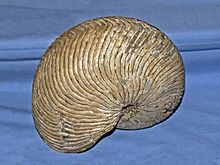| Cymatoceras Temporal range: Late Jurassic - Late Oligocene ~155–23 Ma PreꞒ Ꞓ O S D C P T J K Pg N | |
|---|---|

| |
| Cymatoceras species from Albian of Madagascar | |
| Scientific classification | |
| Domain: | Eukaryota |
| Kingdom: | Animalia |
| Phylum: | Mollusca |
| Class: | Cephalopoda |
| Subclass: | Nautiloidea |
| Order: | Nautilida |
| Family: | †Cymatoceratidae |
| Genus: | †Cymatoceras Hyatt, 1884 |
| Species | |
|
See text | |
Cymatoceras is a wide-ranging extinct genus from the nautilitacean cephalopod family, Cymatoceratidae. They lived from the Late Jurassic to Late Oligocene, roughly from 155 to 23 Ma.
Species
The following species of Cymatoceras have been described:
- C. albense
- C. atlas
- C. bayfieldi
- C. bifidum
- C. bifurcatum
- C. carlottense
- C. cenomanense
- C. colombiana
- C. crebricostatum
- C. deslongchampsianum
- C. eichwaldi
- C. elegans
- C. hendersoni
- C. hilli
- C. honmai
- C. hunstantonensis
- C. huxleyanum
- C. karakaschi
- C. kayeanum
- C. kossmati
- C. loricatum
- C. ludevigi
- C. manuanensis
- C. mikado
- C. neckerianum
- C. negama
- C. neocomiense
- C. pacificum
- C. paralibanoticum
- C. patagonicum
- C. patens
- C. perstriatum
- C. picteti
- C. pseudoatlas
- C. pseudoelegans
- C. pseudoneokomiense
- C. pseudonegama
- C. pulchrum
- C. radiatum
- C. renngarteni
- C. sakalavum
- C. sarysuense
- C. savelievi
- C. semilobatum
- C. sharpei
- C. tenuicostatum
- C. tourtiae
- C. tskaltsithelense
- C. tsukushiense
- C. virgatum
- C. yabei
Description
Its shell is generally subglobular, variably involute with a rounded whorl section. Sides and venter bear conspicuous ribs. The suture is only slightly sinuous and the siphuncle position is variable.
Paracymatoceras, coeval during the Late Jurassic and Early Cretaceous differs primarily in having a more sinuous suture. Neocymatoceras tsukushiense from the Oligocene Ashiya Group of Japan, described by Kobayashi, 1954, has been reassigned to Cymatoceras.
Fossil record
Fossils of Cymatoceras are found in marine strata from the Jurassic until the Oligocene (age range: from 155.7 to 23 million years ago.). Fossils are known from several localities:
- Jurassic
Mexico
- Cretaceous
Antarctica, Argentina, Armenia, Azerbaijan, Chile, Colombia (Payandé, Tolima and La Guajira), France, Georgia, Germany, Greenland, India, Italy, Japan, Kazakhstan, Madagascar, Mexico, Morocco, Mozambique, Papua New Guinea, Poland, the Russian Federation, Switzerland, Tanzania, Turkmenistan, Ukraine, the United Kingdom, United States (California, New Mexico, Texas).
- Oligocene
Japan
References
- ^ Fossilworks
- Sepkoski, Jack Sepkoski's Online Genus Database – Cephalopodes
- ^ Bernhard Kummel, 1964. Nautiloidea - Nautilida. Treatise on Invertebrate Paleontology Part K. Geol Soc of America and Univ Kans Press, Teichert & Moore (eds)
| Taxon identifiers | |
|---|---|
| Cymatoceras | |
- Prehistoric nautiloid genera
- Late Jurassic genus first appearances
- Oligocene genus extinctions
- Mesozoic Antarctica
- Cretaceous animals of Africa
- Cretaceous animals of Asia
- Cretaceous cephalopods of Europe
- Jurassic cephalopods of North America
- Jurassic Mexico
- Cretaceous cephalopods of North America
- Cretaceous Mexico
- Cretaceous United States
- Cretaceous animals of South America
- Cretaceous Argentina
- Cretaceous Chile
- Cretaceous Colombia
- Fossil taxa described in 1884